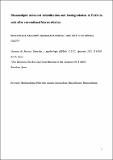Por favor, use este identificador para citar o enlazar a este item:
http://hdl.handle.net/10261/178096COMPARTIR / EXPORTAR:
 SHARE SHARE
 CORE
BASE CORE
BASE
|
|
| Visualizar otros formatos: MARC | Dublin Core | RDF | ORE | MODS | METS | DIDL | DATACITE | |

| Título: | Rhamnolipid-enhanced solubilization and biodegradation of PAHs in soils after conventional bioremediation |
Autor: | Posada Baquero, Rosa CSIC ORCID; Grifoll, Magdalena; Ortega Calvo, J. J. CSIC ORCID | Palabras clave: | Biodegradation Bioremediation Biosurfactants Polycyclic aromatic hydrocarbons |
Fecha de publicación: | 10-jun-2019 | Editor: | Elsevier | Citación: | Science of the Total Environment (668) 790-796 (2019) | Resumen: | The application of a rhamnolipid biosurfactant for enhanced solubilization and biodegradation of slowly desorbing polycyclic aromatic hydrocarbons (PAHs) in contaminated soils was determined in this study. The soil samples exhibited different levels of pollution and different bioremediation stages: the first soil originated from a creosote-polluted site, contained 4370 mg kg −1 of PAHs and had not been bioremediated; the second soil was the same as the first but had received bioremediation treatment with nutrient amendment in biopiles for a period of 5 months and contained 580 mg kg −1 of PAHs after this treatment; the third soil was treated by bioremediation for several years to reduce the concentration of PAHs to 275 mg kg −1 . The kinetics of PAH desorption were determined to assess the magnitude of the slowly desorbing fractions present in the polluted soil and to optimize the biosurfactant effectiveness in terms of biodegradation. The soils that had been treated by bioremediation were enriched in slowly desorbing PAHs. The rhamnolipid at a concentration above its critical micelle concentration enhanced biodegradation in the soils that had been bioremediated previously. The measurement of residual concentrations of native PAHs showed the promoting effect of the biosurfactant on the biodegradation of the slowly desorbing fractions. Interestingly, benzo(a)pyrene was biodegraded in the soil that had been bioremediated for a long time. Rhamnolipid can constitute a valid alternative to chemical surfactants in promoting the biodegradation of slow-desorption PAHs, which is one of the most important problems in bioremediation, but the efficiency depends strongly on the bioremediation stage in which the biosurfactant is applied | Descripción: | 7 páginas.-- 4 figuras.-- 6 tablas.-- 18 referencias.-- Supplementary data to this article can be found online at https://doi. org/10.1016/j.scitotenv.2019.03.056 | Versión del editor: | http://dx.doi.org/10.1016/j.scitotenv.2019.03.056 | URI: | http://hdl.handle.net/10261/178096 | DOI: | 10.1016 / j.scitotenv.2019.03.056 | ISSN: | 0048-9697 |
| Aparece en las colecciones: | (IRNAS) Artículos |
Ficheros en este ítem:
| Fichero | Descripción | Tamaño | Formato | |
|---|---|---|---|---|
| Rhamnolipid-enhanced_solubilization_biodegradation_PAH_soils_conventional_bioremediation_2019_Postprint.pdf | 992,47 kB | Adobe PDF |  Visualizar/Abrir |
CORE Recommender
Page view(s)
281
checked on 19-abr-2024
Download(s)
172
checked on 19-abr-2024
Google ScholarTM
Check
Altmetric
Altmetric
NOTA: Los ítems de Digital.CSIC están protegidos por copyright, con todos los derechos reservados, a menos que se indique lo contrario.
